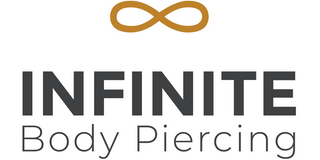There is no single cleaning solution or aftercare regimen that works for everyone. Different bodies, different lifestyles, and different climates demand different aftercare. You must find what works for you. New piercings should be cleaned twice daily for the entire healing period. Do not overclean your piercing. Cleaning too often with a harsh solution, or with many different solutions can irritate your piercing. Your immune system is working to heal the piercing, you just need to keep it clean and dry so your body can do its job.
Use a Sterile Saline Spray
Spray saline solution over the piercing to thoroughly irrigate the area. Your jewelry does not need to be rotated. Do not simply dip cotton balls or swabs in a saline solution and apply it to the skin; you must thoroughly irrigate the piercing to clean it effectively.Popular brands of sterile saline spray include H2Ocean®, Steri-Wash®, NeilMed® saline solution, and Simply Saline™ Wound Wash. Saline for cleaning contact lenses is not recommended. Check the first aid aisle and look for saline formulated for wound care.
…Or Just Use Plain Water
Flushing the wound promotes healing, so even plain water is an effective cleaning agent. If you shower once a day, use that time to thoroughly rinse and irrigate your piercing, and use your spray saline solutions as a portable cleaning solution for your second cleaning of the day. That’s it!
For Oral Piercings, Rinse Your Mouth
When healing lip, cheek, philtrum, beauty mark, or tongue piercings, rinse your mouth with water after eating, drinking, or smoking. If you use mouthwash, avoid harsh alcohol-based products like Listerine®, as repeated use can slow healing. Limit non-alcoholic mouthwash rinses to twice a day. Using mouthwash too often will do more harm than good, and plain water is usually all you need.
Keep Surface Piercings & Anchors Covered
When getting pierced at Infinite, fresh surface anchors are generally covered with a BAND-AID® or Tegaderm™ (a clear, breathable, waterproof bandage) after being pierced. Leave this bandage on for 24 hours unless otherwise instructed by your piercer. Once the bandage is off, begin basic piercing care. Surface anchors that do not have a barrier should get a saline rinse the first night, and then regular rinses twice daily after for the duration of the healing period.
For Genital Piercings, Keep It Simple
Like other piercings, irrigation is the key to keeping your piercing clean, and a regimen of sterile saline and plain water rinses is usually ideal. Stay away from anything too harsh, especially with vulva piercings, as it can upset the natural balance of flora—even contributing to a yeast infection.
Do Not:
Do not use rubbing alcohol or hydrogen peroxide. These are both too harsh for long-term use and can actually slow healing.
Do not use Neosporin,® bacitracin, or triple antibiotic ointments. These are not meant to be used for more than two weeks, and are not meant for puncture wounds.
Do not take out your jewelry during the healing period. If you want to keep your piercings, keep jewelry in them. After your piercing is healed you can change your jewelry, but jewelry should never be left out for longer than the time it takes to insert a new piece.
Do not touch your fresh piercing with dirty hands. You do not need to rotate or twist your jewelry during healing. Unless you are cleaning your piercing, keep your hands off!
Don’t be surprised by some spotty bleeding or bruising. You may get a little bit of bleeding immediately after being pierced, and it’s not uncommon to get some bruising, either.
Don’t be afraid to ask for help. Everyone heals a little differently. If you’re concerned about your piercing, feel free to reach out to us with any questions.
Jewelry Downsizing
You should expect some swelling with most new piercings, often starting immediately and lasting over several weeks. It is important to get more snug-fitting jewelry inserted after the initial swelling has gone down. This is what we refer to as “downsizing” the jewelry in a piercing.
You should return to the studio after your initial swelling period to have your piercing checked and jewelry downsized. For most piercings, this is usually no earlier than six weeks and no later than eight weeks. (For oral piercings, we recommend coming back between two and three weeks).
If swelling subsides and jewelry is “poking out” of the piercing, feel free to come in earlier. Likewise, if your piercing is still filling the full wearable surface of your jewelry at the suggested check-in date, you can probably wait a few more weeks. Everyone is different. Healing and downsize times are approximate; your body has its own timeline.
When you’re pierced at our studio, we waive the jewelry change fee for downsizing, but you will need to purchase a new post. You can continue wearing the same end (or top) you were initially pierced with.

Care for more?
Our comprehensive aftercare guides were written for our customers from our years of experiencee. Every body and piercing is different, but it is our goal is to make sure you have a great outcome and a fast and worry-free healing process. Check out our pages below for instructions on specific piercings, tips and troubleshooting.
The information contained here is based on our experience as piercers and upon current industry standards. We are not doctors, and our suggestions, whether written or verbal, stated or implied, are not meant as a substitute for medical advice. In the event of a serious infection or other problem, consult your physician, keeping in mind they may be unfamiliar with issues related specifically to body piercing.

